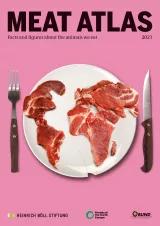
More than a third of all crops worldwide end up in the stomachs of livestock. That includes one billion tonnes a year of
soybeans and maize alone. The feed and livestock industries want to increase that even further.

Global meat consumption has been rising for years, pushing up demand for livestock feed. For intensive animal agriculture, soybeans are one of the most important sources of protein in feed. Their share of international trade has risen more than fivefold since 2001. Soy is also used in human food, fuel and industrial materials, but almost 90 percent ends up in feed troughs.
The biggest soybean producers are Brazil, at 133 million tonnes, the USA at 117 million, and Argentina at 53 million. Almost 90 percent of global soybean exports in 2019 came from these three countries. At 74 million tonnes, Brazil is the biggest exporter, followed by the USA. As cultivation has expanded, so too has the proportion of farmland sown with genetically modified soybeans. In the USA it is now 94 percent, while in Brazil, 97 percent of the 2017 harvest consisted of genetically modified varieties. Soybeans account for almost 50 percent of all genetically modified organisms, or GMOs, worldwide. Rising demand for feed has stimulated an increase in the soybean acreage of over 70 million hectares in the last 20 years.
China is by far the biggest producer and consumer of meat worldwide. It has a correspondingly large appetite for feed, making it the world’s biggest soybean importer. In 2019 it bought 74 million tonnes of the beans, almost two-thirds of all exports. It was followed by the European Union, with 13 million tonnes. Changes in global trade flows can be similarly dramatic: between January and May 2020, China imported almost 37 percent more soybeans from Brazil, and bought less from the USA as a result of trade tensions.
Soybeans are processed into feed and traded by agricultural trading companies that invest in ports, ships and logistics around the globe. The biggest grain traders are the so-called ABCD companies: Archer Daniels Midland, Bunge, Cargill, and Louis Dreyfus Commodities. In 2018 they, along with the Brazilian trader Amaggi, were responsible for 56 percent of Brazilian soybean exports. Because demand is rising and it is difficult to push up yields on current fields, more land is needed to grow soy. In the 20 years leading up to 2019, the cultivated area grew from 77 to 125 million hectares. Soybean cultivation is now the second largest contributor to deforestation worldwide, after livestock farming. It is especially in Brazil and Argentina that forests and grasslands are being turned into soybean fields.
Between 2006 and 2017, some 220,000 square kilometres were cleared in the Amazon rainforest and the Cerrado savanna, a dry forest in Brazil valuable for its biodiversity. That is the same area as England, Wales and Scotland combined, or half the size of France. Most of the land was turned into livestock pasture, but 10 percent was used directly for soybean cultivation, according to a study by the initiative Trase, Transparency for Sustainable Economies. The massive deforestation in the Cerrado has a simple cause: the Amazon moratorium, which since 2008 has successfully prohibited trade in soybeans that come from areas cleared of rainforest – but only in the Amazon. Soybean production has simply shifted to the Cerrado.
None of the big grain traders support the demand to extend the moratorium to the Cerrado. Cargill has even spoken out publicly against the idea. And in the Amazon, the moratorium applies only to land that has been deforested specifically to grow soy. Soybeans that are cultivated on land originally cleared for other reasons are not affected. That means that most of the soybean expansion is on former pastureland that used to be forest or savanna.
Progress can quickly be undone. This is shown by the forest fires of 2019 and 2020, which were mostly a result of slash-and-burn cultivation, including for soybean farming. A comparison of satellite images of the fires with maps showing the largest meat processing plants and soybean silos reveals that many fires blazed in the immediate vicinity of those plants, warehouses and other infrastructure. This was supported by the policies of Brazilian President Jair Bolsonaro, who has continuously relaxed the country’s environmental regulations. He has not only welcomed the expansion of agribusiness in the rainforest and savanna, he has also legalized it. In 2019, the deforestation rate in Brazil rose to its highest level since 2007/8. Forecasts predict that it will rise further.
A study published in the respected journal Science in 2020 found that 20 percent of the soybeans exported to the European Union from the Amazon and Cerrado come from land that has been cleared illegally. Meat consumption in Europe is thus directly linked to deforestation in Brazil, and to the conflicts that result from it. Alongside its negative impact on climate and biodiversity, deforestation also causes disputes over land and violates the rights of indigenous communities. Global Witness, a non-governmental organization, says that conflicts between local communities and soybean and livestock farmers are on the rise, along with threats and violence against those who stand up for their ancestral land and for the climate. In 2019, 24 environmental activists were killed in Brazil – 90 percent of them in the Amazon region.


